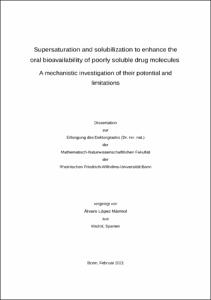Supersaturation and solubilization to enhance the oral bioavailability of poorly soluble drug moleculesA mechanistic understanding of their potential and limitations

Supersaturation and solubilization to enhance the oral bioavailability of poorly soluble drug molecules
A mechanistic understanding of their potential and limitations

| dc.contributor.advisor | Wagner, Karl G. | |
| dc.contributor.author | López Mármol, Álvaro | |
| dc.date.accessioned | 2021-07-28T07:31:37Z | |
| dc.date.available | 2023-08-01T22:00:21Z | |
| dc.date.issued | 28.07.2021 | |
| dc.identifier.uri | https://hdl.handle.net/20.500.11811/9238 | |
| dc.description.abstract | The stabilization of the supersaturated state in solution was in the last few decades identified as a suitable strategy to enhance the oral bioavailability of poorly soluble drug molecules. From this point of view, drug molecules presenting a low solubility in biorelevant media and a high permeability through biological membranes could potentially benefit in terms of an increased oral exposure from a long termed stabilization in solution. Through the increasing interest in amorphous solid dispersions as a formulation strategy to overcome poor oral bioavailability issues, water soluble polymers became some of the most commonly used excipients in the fied of solubility and oral bioavailability enhancement.
Despite several efforts made in the last few years, an understanding of the complex supersaturation and/or solubilization process, together with a reliable prediction of the solubility enhancement effects on oral exposure was not fully achieved. Furthermore, in most of the cases the focus was mainly placed on enabling formulations in the form of supersaturated drug delivery systems. On this way, no isolated consideration of the real effect of pure supersaturation on bioavailability was accomplished without being biased by additional drug formulation effects. The present work targeted the effects of supersaturation and solubilization by means of water soluble polymers on six poorly soluble model drug molecules. These were investigated from three different perspectives: physicochemical, in vitro (biorelevant) and in vivo (physiological). The physicochemical investigations facilitated the differentiation between supersaturating and solubilizing drug/polymer combinations, as well as the (ir)reversibility of the stabilizing effects as a function of the inherent supersaturation behavior of the drug molecules. Additionally, it provided important insights on the underlying stabilization mechanisms in aqueous solution from a thermodynamic perspective. Based on the knowledge gained in the first part of the studies, the same drug/polymer combinations were investigated under an in vitro model simulating the conditions of the gastrointestinal tract. With this, the potential of the polymers to delay precipitation and enhance oral absorption was investigated in vitro from a kinetic point of view under monophasic and biphasic dissolution tests. The ability of the polymers to enhance the partition of the drug molecules was identified to be highly dependent on the inherent supersaturation ability of the drug molecules, as well as on the physical state of the precipitating form. Finally, based on the in vitro results, three model drugs were selected for investigation under an in vivo rat model. The potential of pure supersaturation and solubilization effects to induce changes in the oral exposure of the drug molecules was confirmed in vivo and the predictability of the in vitro models was equally demonstrated by the establishment of an in vitro-in vivo correlation. The relationship established between all three approaches highlighted the importance of targeting a combined physicochemical and in vitro investigation of supersaturation and solubilization, with the aim of predicting their potential to induce changes in the in vivo oral bioavailability. On this manner, it represents a valuable contribution to the field of solubility and bioavailability enhancement, where the joint forces of the scientific community is still nowadays highly needed. | en |
| dc.language.iso | eng | |
| dc.rights | Namensnennung - Nicht kommerziell - Keine Bearbeitungen 4.0 International | |
| dc.rights.uri | http://creativecommons.org/licenses/by-nc-nd/4.0/ | |
| dc.subject | Schwer lösliche Wirkstoffe | |
| dc.subject | Polymere | |
| dc.subject | Übersättigung | |
| dc.subject | Physikochemische Eigenschaften | |
| dc.subject | In vitro biorelevante Methoden | |
| dc.subject | Pharmakokinetik | |
| dc.subject | Poorly soluble drugs | |
| dc.subject | polymers | |
| dc.subject | supersaturation | |
| dc.subject | physicochemical properties | |
| dc.subject | in vitro biorelevant tools | |
| dc.subject | pharmacokinetic | |
| dc.subject.ddc | 615 Pharmakologie, Therapeutik | |
| dc.title | Supersaturation and solubilization to enhance the oral bioavailability of poorly soluble drug molecules | |
| dc.title.alternative | A mechanistic understanding of their potential and limitations | |
| dc.type | Dissertation oder Habilitation | |
| dc.publisher.name | Universitäts- und Landesbibliothek Bonn | |
| dc.publisher.location | Bonn | |
| dc.rights.accessRights | openAccess | |
| dc.identifier.urn | https://nbn-resolving.org/urn:nbn:de:hbz:5-63300 | |
| ulbbn.pubtype | Erstveröffentlichung | |
| ulbbnediss.affiliation.name | Rheinische Friedrich-Wilhelms-Universität Bonn | |
| ulbbnediss.affiliation.location | Bonn | |
| ulbbnediss.thesis.level | Dissertation | |
| ulbbnediss.dissID | 6330 | |
| ulbbnediss.date.accepted | 29.04.2021 | |
| ulbbnediss.institute | Mathematisch-Naturwissenschaftliche Fakultät : Fachgruppe Pharmazie / Pharmazeutisches Institut | |
| ulbbnediss.fakultaet | Mathematisch-Naturwissenschaftliche Fakultät | |
| dc.contributor.coReferee | Lamprecht, Alf | |
| ulbbnediss.date.embargoEndDate | 01.08.2023 | |
| ulbbnediss.contributor.gnd | 1318393078 |
Dateien zu dieser Ressource
Das Dokument erscheint in:
-
E-Dissertationen (4077)




